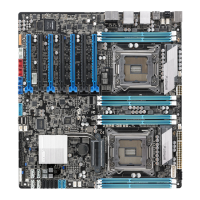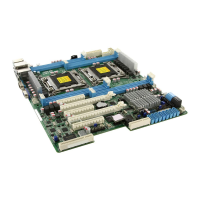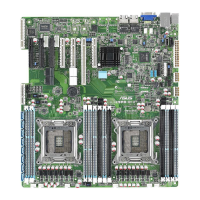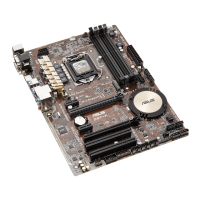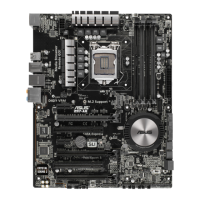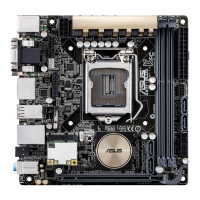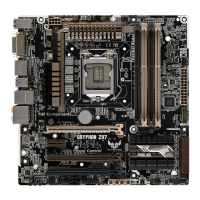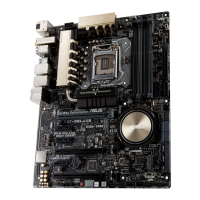Do you have a question about the Asus Z9PE-D16 and is the answer not in the manual?
Details FCC compliance statement for the device, including conditions for operation and interference.
States compliance with Class B limits for radio noise emissions from digital apparatus per Canadian regulations.
Information on compliance with the REACH regulatory framework for chemical substances in products.
Precautions to prevent electrical shock hazards, including handling power cables and grounding.
Guidelines for safe installation and operation of the motherboard and components, avoiding damage.
Outlines the structure of the user guide, detailing the content of each chapter.
Provides sources for additional information, including ASUS websites and optional documentation.
Explains typographical conventions like bold text, italics, and key notations used throughout the manual.
A welcome message for the user, introducing the motherboard's features and technologies.
Lists the items included in the motherboard package for both gift box and bulk pack options.
Instructs users to note the motherboard's serial number for technical support purposes.
Highlights key features and technologies supported by the motherboard.
Provides essential precautions before installing motherboard components or changing settings.
Details the motherboard's layout, including placement direction and screw hole locations.
Covers the CPU socket type and instructions for installing the CPU on the motherboard.
Explains DDR3 DIMM sockets and provides configurations for installing system memory modules.
Describes the expansion slots and provides guidance on installing and configuring expansion cards.
Details the function and configuration of various jumpers on the motherboard.
Illustrates and describes rear panel and internal connectors on the motherboard.
Explains the purpose and indication of internal LEDs on the motherboard.
Step-by-step instructions for initial system startup after assembly.
Details methods for shutting down the system using the OS or the power switch.
Information on BIOS utilities for management, recovery, and updating the system BIOS.
Explains how to enter and navigate the BIOS setup utility for system configuration.
Describes the main BIOS screen, system information, and basic settings like date and time.
Covers advanced system settings for CPU, chipset, and various devices.
Details server management settings, including event logs and network configuration.
Explains how to manage and view system event logs within the BIOS setup.
Provides options for configuring system boot priorities and related settings.
Displays system temperatures, voltages, fan speeds, and allows fan control settings.
Covers system security settings, including administrator and user passwords.
Provides access to special function utilities, such as BIOS update tools.
Options for saving changes, discarding changes, and restoring default BIOS settings.
Introduces RAID solutions and defines different RAID levels (0, 1, 10, 5).
Step-by-step guide for creating, managing, and initializing RAID sets using the LSI utility.
Instructions for creating and managing RAID volumes using Intel's SCU/SATA Option ROM utility.
Guide for using the Intel RSTe utility within Windows for RAID volume creation and management.
Instructions for creating RAID driver disks and installing RAID controller drivers during OS setup.
Step-by-step guide to install the Intel chipset device software for system functionality.
Instructions for installing the Intel Network Connections software for network adapter functionality.
Guide for installing the ASPEED Video Graphics Adapter (VGA) driver for display output.
Instructions for installing the Intel C600 Series Chipset SCU SATA RAID Driver.
Guidance on installing the Microsoft .NET Framework 3.5 SP1 software required for certain applications.
Steps to install the Intel Rapid Storage Technology enterprise 3.0 utility for storage management.
Instructions for installing the Intel I350 Gigabit Adapters driver for network connectivity.
Details on installing management applications and utilities from the support DVD.
A visual representation of the Z9PE-D16 motherboard's architecture and component connections.
A visual representation of the Z9PE-D16/2L motherboard's architecture and component connections.
Details FCC compliance statement for the device, including conditions for operation and interference.
States compliance with Class B limits for radio noise emissions from digital apparatus per Canadian regulations.
Information on compliance with the REACH regulatory framework for chemical substances in products.
Precautions to prevent electrical shock hazards, including handling power cables and grounding.
Guidelines for safe installation and operation of the motherboard and components, avoiding damage.
Outlines the structure of the user guide, detailing the content of each chapter.
Provides sources for additional information, including ASUS websites and optional documentation.
Explains typographical conventions like bold text, italics, and key notations used throughout the manual.
A welcome message for the user, introducing the motherboard's features and technologies.
Lists the items included in the motherboard package for both gift box and bulk pack options.
Instructs users to note the motherboard's serial number for technical support purposes.
Highlights key features and technologies supported by the motherboard.
Provides essential precautions before installing motherboard components or changing settings.
Details the motherboard's layout, including placement direction and screw hole locations.
Covers the CPU socket type and instructions for installing the CPU on the motherboard.
Explains DDR3 DIMM sockets and provides configurations for installing system memory modules.
Describes the expansion slots and provides guidance on installing and configuring expansion cards.
Details the function and configuration of various jumpers on the motherboard.
Illustrates and describes rear panel and internal connectors on the motherboard.
Explains the purpose and indication of internal LEDs on the motherboard.
Step-by-step instructions for initial system startup after assembly.
Details methods for shutting down the system using the OS or the power switch.
Information on BIOS utilities for management, recovery, and updating the system BIOS.
Explains how to enter and navigate the BIOS setup utility for system configuration.
Describes the main BIOS screen, system information, and basic settings like date and time.
Covers advanced system settings for CPU, chipset, and various devices.
Details server management settings, including event logs and network configuration.
Explains how to manage and view system event logs within the BIOS setup.
Provides options for configuring system boot priorities and related settings.
Displays system temperatures, voltages, fan speeds, and allows fan control settings.
Covers system security settings, including administrator and user passwords.
Provides access to special function utilities, such as BIOS update tools.
Options for saving changes, discarding changes, and restoring default BIOS settings.
Introduces RAID solutions and defines different RAID levels (0, 1, 10, 5).
Step-by-step guide for creating, managing, and initializing RAID sets using the LSI utility.
Instructions for creating and managing RAID volumes using Intel's SCU/SATA Option ROM utility.
Guide for using the Intel RSTe utility within Windows for RAID volume creation and management.
Instructions for creating RAID driver disks and installing RAID controller drivers during OS setup.
Step-by-step guide to install the Intel chipset device software for system functionality.
Instructions for installing the Intel Network Connections software for network adapter functionality.
Guide for installing the ASPEED Video Graphics Adapter (VGA) driver for display output.
Instructions for installing the Intel C600 Series Chipset SCU SATA RAID Driver.
Guidance on installing the Microsoft .NET Framework 3.5 SP1 software required for certain applications.
Steps to install the Intel Rapid Storage Technology enterprise 3.0 utility for storage management.
Instructions for installing the Intel I350 Gigabit Adapters driver for network connectivity.
Details on installing management applications and utilities from the support DVD.
A visual representation of the Z9PE-D16 motherboard's architecture and component connections.
A visual representation of the Z9PE-D16/2L motherboard's architecture and component connections.
| Microphone in | No |
|---|---|
| Serial ports quantity | 0 |
| USB 2.0 ports quantity | 2 |
| Ethernet LAN (RJ-45) ports | 4 |
| USB 2.0 connectors | 3 |
| Chassis intrusion connector | Yes |
| PCI Express x16 slots | 6 |
| PCI Express slots version | 3.0 |
| PCI Express configurations | 1x16 |
| Memory channels | Quad-channel |
| Maximum RDIMM memory | 512 GB |
| Supported memory types | DDR3-SDRAM |
| Supported memory clock speeds | 1066, 1333, 1600 MHz |
| Number of DIMM slots | 16 |
| Supported RDIMM module capacity | 16GB, 2GB, 4GB, 8GB |
| Supported UDIMM module capacity | 2GB, 4GB, 8GB |
| RAID levels | 0, 1, 5, 10 |
| Supported storage drive interfaces | SATA, SATA II, SATA III |
| On-board graphics card model | Aspeed AST2300 |
| On-board graphics card memory | 16 MB |
| Parallel processing technology support | Not supported |
| Certification | US (FCC, CFR47 15 A), Europe (CE, EN55022 / EN55024), Australia (C-TICK) |
| Motherboard chipset | Intel® C602 |
| Cables included | SATA, USB |
| Storage temperature (T-T) | -40 - 70 °C |
| Operating temperature (T-T) | 10 - 35 °C |
| Operating relative humidity (H-H) | 20 - 90 % |
| Supported QPI | 6.4, 7.2 GT/s |
| Processor socket | LGA 2011 (Socket R) |
| Processor manufacturer | Intel |
| Processor number of cores supported | 4, 8 |
| Ethernet interface type | Gigabit Ethernet |
| Depth | 330 mm |
|---|---|
| Width | 305 mm |
